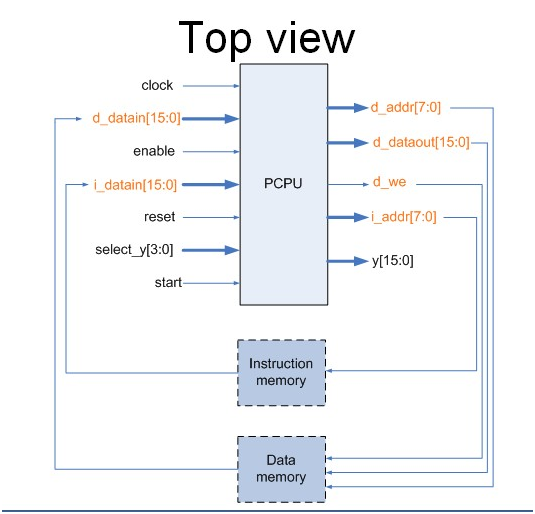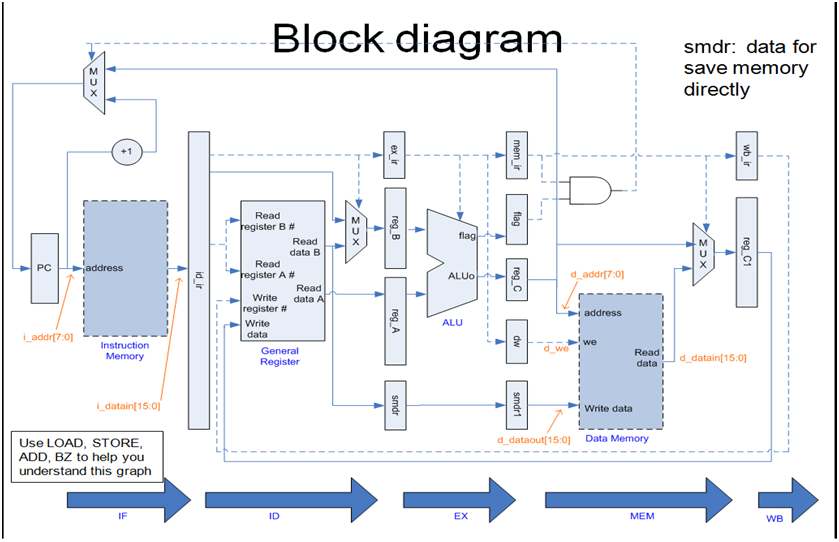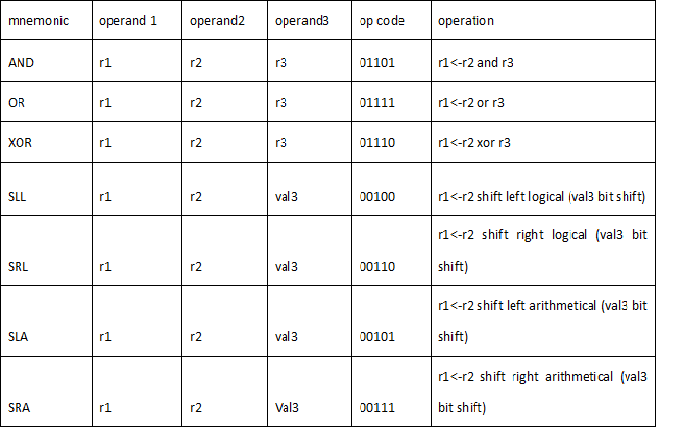实现一个简易的五级流水的CPU,解决Hazard,并实现板极验证。
1 设计总览

2 实现原理
根据Top view 将整个CPU分为3个模块:
1 PCPU 主要模块:用从指令内存得到的指令进行运算处理,并从数据内存中写入或读取数据。这是最核心的部分,其他模块都很好设计。
2 Instruction_Mem 指令模块: 为PCPU模块提供指令,使得PCPU中通过指令寄存器中的值,找到指令的内存地址,从而读取指令。
3 Data_Mem 数据模块: PCPU从中读取数据或写入数据
板极验证:
用4个开关表示选择哪一个数据显示,用4个7段数码管显示数字
3 整个PCPU的工作流程:
五级流水:

注释:
IF : 从指令模块中,通过指令寄存器PC寻址,获得指令。
ID: 解码指令,根据操作码提取要用到的数据输入通用寄存器。
EX: ALU运算单元在指令的调度下,使用之前通用寄存器中的数据根据不同指令完成不同运算。运算后将结果输出到reg_C中,并设置各个标记位的值。
MEM:这里主要是针对LOAD,STORE这类的读写指令要用到的。对于其他指令没有特别要求。
WB:回写把计算结果写入指令的左值中,这里除了跳转指令和load,store指令,都是写回第一个操作数(寄存器)
4 需要实现的汇编指令



5 分阶段实现优化过程
阶段一 : 实现最基本的cpu(没有指令存储器,数据存储器,没有解决hazard,没有板极验证,什么也没有…)
完成步骤:
步骤1:理解流水线工作原理
上课时流水线是听懂了,寄存器赋值,取数这些基本原理大概弄懂了。不过实际操作还是有很多要注意的。
步骤2:开始逐级编写基本代码
有了老师给的样例代码,整个框架基本构建好了。所以要做的就是弄清楚每个指令在每一级流水中需要做些什么,然后在每一级流水中再总结这些操作的共同点,不同点,需要特别注意的地方。
1)指令操作码的设计:
优化:这里考虑了一下控制指令的特殊性,因为控制指令在流水每一级操作中有很大相似性,所以为了简化电路,还有判断时代码的简化,把所有控制指令的前两位设为“11”,而其他指令前两位都不是“11”。这样编写代码的时候更容易理清逻辑,综合的时候电路也简单一些。
2)指令各级流水的设计:
这里思考了很多,设计每一条指令都需要特别小心,最重要的是在ID和EX还有ALUo中。
总结一下,主要就是整个16 bits的指令在流水线的每一步中起到“指挥”作用,然后每一级流水的工作就是在上一级完成后,利用
A ID中的寄存器赋值:
reg_A 和 reg_B中存储的是在指令右边将要送入ALU参与运算的值。
由于指令的右边通常声明的是寄存器的编号(因为用户只能对通用寄存器进行操作,无法直接访问内存)或者立即数,所以要通过编号找到确定的寄存器,再将该通用寄存器里的值赋给reg_A 或者 reg_B。
优化: 这里为了减少reg_A 和 reg_B的翻转,考虑了一些优化。比如把要用到立即数的指令的立即数不写入寄存器,而是在下一级流水中之间从指令中取数。
B ex中ALUo的计算
主要就是用verilog本身的运算直接操作。运算后赋值个ALUo寄存器和cf标志位。
优化:比如一些用立即数的操作,之前没有存入reg_A 和 reg_B,直接从ex_ir中取数计算。
C mem中的读写
主要要和data模块进行数据传输,指令就是load和store。
D wb中写回运算结果
由于算数指令和逻辑运算指令基本都是要写回到寄存器。所以这里判断为:非跳转指令,非store,load指令,则写回第一个操作数(寄存器)。
6 源代码
1).v
`timescale 1ns / 1ps
//
// Company:
// Engineer:
//
// Create Date: 14:15:05 12/18/2014
// Design Name:
// Module Name: CPU
// Project Name:
// Target Devices:
// Tool versions:
// Description:
//
// Dependencies:
//
// Revision:
// Revision 0.01 - File Created
// Additional Comments:
//
//
// data transfer & Arithmetic
`define NOP 5'b00000
`define HALT 5'b00001
`define LOAD 5'b00010
`define STORE 5'b00011
`define LDIH 5'b10000
`define ADD 5'b01000
`define ADDI 5'b01001
`define ADDC 5'b10001
`define SUB 5'b01011
`define SUBI 5'b10011
`define SUBC 5'b10111
`define CMP 5'b01100
// control
`define JUMP 5'b11000
`define JMPR 5'b11001
`define BZ 5'b11010
`define BNZ 5'b11011
`define BN 5'b11100
`define BNN 5'b11101
`define BC 5'b11110
`define BNC 5'b11111
// logic / shift
`define AND 5'b01101
`define OR 5'b01111
`define XOR 5'b01110
`define SLL 5'b00100
`define SRL 5'b00110
`define SLA 5'b00101
`define SRA 5'b00111
// general register
`define gr0 3'b000
`define gr1 3'b001
`define gr2 3'b010
`define gr3 3'b011
`define gr4 3'b100
`define gr5 3'b101
`define gr6 3'b110
`define gr7 3'b111
// FSM
`define idle 1'b0
`define exec 1'b1
/******* the whole module CPU is made of Instuction_Mem module, PCPU module and Data_Mem module ********/
module CPU(
input wire clk, clock, enable, reset, start,
input wire[3:0] select_y,
output [7:0] select_segment,
output [3:0] select_bit
);
wire[15:0] d_datain;
wire[15:0] i_datain;
wire[7:0] d_addr;
wire[7:0] i_addr;
wire[15:0] d_dataout;
wire d_we;
wire[15:0] y;
reg [20:0] count = 21'b0;
Instruction_Mem instruction(clock,reset,i_addr,i_datain);
PCPU pcpu(clock, enable, reset, start, d_datain, i_datain,
select_y, i_addr, d_addr, d_dataout, d_we, y);
Data_memory data(clock, reset, d_addr, d_dataout, d_we, d_datain);
Board_eval eval(clk, y, select_segment, select_bit);
endmodule
/************************ Instruction memeory module *****************************/
module Instruction_Mem (
input wire clock, reset,
input wire[7:0] i_addr,
output [15:0] i_datain
);
reg[15:0] i_data[255:0]; // 8 bits pc address to get instructions
reg[15:0] temp;
always@(negedge clock)
begin
if(!reset)
begin
i_data[0] <= {`LOAD, `gr1, 1'b0, `gr0, 4'b0000};
i_data[1] <= {`LOAD, `gr2, 1'b0, `gr0, 4'b0001};
i_data[2] <= {`ADD, `gr3, 1'b0, `gr1, 1'b0, `gr2};
i_data[3] <= {`SUB, `gr3, 1'b0, `gr1, 1'b0, `gr2};
i_data[4] <= {`CMP, `gr3, 1'b0, `gr2, 1'b0, `gr1};
i_data[5] <= {`ADDC, `gr3, 1'b0, `gr1, 1'b0, `gr2};
i_data[6] <= {`SUBC, `gr3, 1'b0, `gr1, 1'b0, `gr2};
i_data[7] <= {`SLL, `gr2, 1'b0, `gr3, 1'b0, 3'b001};
i_data[8] <= {`SRL, `gr3, 1'b0, `gr1, 1'b0, 3'b001};
i_data[9] <= {`SLA, `gr4, 1'b0, `gr1, 1'b0, 3'b001};
i_data[10] <= {`SRA, `gr5, 1'b0, `gr1, 1'b0, 3'b001};
i_data[11] <= {`STORE, `gr3, 1'b0, `gr0, 4'b0010};
i_data[12] <= {`HALT, 11'b000_0000_0000};
end
else
begin
temp = i_data[i_addr[7:0]];
end
end
assign i_datain = temp;
endmodule
/**************************** PCPU module ***************************/
module PCPU(
input wire clock, enable, reset, start,
input wire [15:0] d_datain, // output from Data_Mem module
input wire [15:0] i_datain, // output from Instruction_Mem module
input wire [3:0] select_y, // for the board evaluation
output [7:0] i_addr,
output [7:0] d_addr,
output [15:0] d_dataout,
output d_we,
output [15:0] y
);
reg [15:0] gr [7:0];
reg nf, zf, cf;
reg state, next_state;
reg dw;
reg [7:0] pc;
reg[15:0] y_forboard;
reg [15:0] id_ir;
reg [15:0] wb_ir;
reg [15:0] ex_ir;
reg [15:0] mem_ir;
reg [15:0] smdr = 0;
reg [15:0] smdr1 = 0;
reg signed [15:0] reg_C1; //有符号
reg signed [15:0] reg_A;
reg signed [15:0] reg_B;
reg signed [15:0] reg_C;
reg signed [15:0] ALUo;
//************* CPU control *************//
always @(posedge clock)
begin
if (!reset)
state <= `idle;
else
state <= next_state;
end
always @(*)
begin
case (state)
`idle :
if ((enable == 1'b1)
&& (start == 1'b1))
next_state <= `exec;
else
next_state <= `idle;
`exec :
if ((enable == 1'b0)
|| (wb_ir[15:11] == `HALT))
next_state <= `idle;
else
next_state <= `exec;
endcase
end
assign i_addr = pc; // 准备下一条指令的地址
//************* IF *************//
always @(posedge clock or negedge reset)
begin
if (!reset)
begin
id_ir <= 16'b0;
pc <= 8'b0;
end
else if (state ==`exec)
// Stall happens in IF stage, always compare id_ir with i_datain to decide pc and id_ir
begin
// 当即将被执行的指令要用到之前load写入的值时, stall two stages , id and ex.
/*
指令中后第二、三个操作数均为寄存器时,需要判断LOAD的第一个操作数是否与这些指令的后两个寄存器有冲突
为一部分算数运算指令和逻辑运算指令
*/
if((i_datain[15:11] == `ADD
||i_datain[15:11] == `ADDC
||i_datain[15:11] == `SUB
||i_datain[15:11] == `SUBC
||i_datain[15:11] == `CMP
||i_datain[15:11] == `AND
||i_datain[15:11] == `OR
||i_datain[15:11] == `XOR)
&&( (id_ir[15:11] == `LOAD && (id_ir[10:8] == i_datain[6:4] || id_ir[10:8] == i_datain[2:0]))
||(ex_ir[15:11] == `LOAD && (ex_ir[10:8] == i_datain[6:4] || ex_ir[10:8] == i_datain[2:0]))
)
) // end if
begin
id_ir <= 16'bx;
pc <= pc; // hold pc
end
/*
指令中第二个操作数为寄存器变量并参与运算时,需要判断LOAD的第一个操作数是否与这些指令的第二个操作数的寄存器有冲突
为移位指令和STORE指令
*/
else if (( i_datain[15:11] == `SLL
||i_datain[15:11] == `SRL
||i_datain[15:11] == `SLA
||i_datain[15:11] == `SRA
||i_datain[15:11] == `STORE)
&&((id_ir[15:11] == `LOAD &&(id_ir[10:8] == i_datain[6:4]))
||(ex_ir[15:11] == `LOAD &&(ex_ir[10:8] == i_datain[6:4]))
)
)
begin
id_ir <= 16'bx;
pc <= pc; // hold pc
end
/*
跳转指令系列,id和ex阶段都需要stall,mem阶段跳转
*/
else if(id_ir[15:14] == 2'b11 || ex_ir[15:14] == 2'b11)
begin
id_ir <= 16'bx;
pc <= pc; // hold pc
end
/* mem阶段跳转 */
else
begin
// BZ & BNZ
if(((mem_ir[15:11] == `BZ)
&& (zf == 1'b1))
|| ((mem_ir[15:11] == `BNZ)
&& (zf == 1'b0)))
begin
id_ir <= 16'bx;
pc <= reg_C[7:0];
end
// BN & BNN
else if(((mem_ir[15:11] == `BN)
&& (nf == 1'b1))
|| ((mem_ir[15:11] == `BNN)
&& (nf == 1'b0)))
begin
id_ir <= 16'bx;
pc <= reg_C[7:0];
end
// BC & BNC
else if(((mem_ir[15:11] == `BC)
&& (cf == 1'b1))
|| ((mem_ir[15:11] == `BNC)
&& (cf == 1'b0)))
begin
id_ir <= 16'bx;
pc <= reg_C[7:0];
end
// JUMP
else if((mem_ir[15:11] == `JUMP)
|| (mem_ir[15:11] == `JMPR))
begin
id_ir <= 16'bx;
pc <= reg_C[7:0];
end
// 非跳转指令且没有检测到冲突
else
begin
id_ir <= i_datain;
pc <= pc + 1;
end
end // end else
end // else reset
end // end always
//************* ID *************//
always @(posedge clock or negedge reset)
begin
if (!reset)
begin
ex_ir <= 16'b0;
reg_A <= 16'b0;
reg_B <= 16'b0;
smdr <= 16'b0;
end
else if (state == `exec)
//Data forwarding happens in ID stage, always check id_ir to decide reg_A/B
begin
ex_ir <= id_ir;
// ********************reg_A 赋值******************* //
/* 其他无冲突的情况 */
// reg_A <= r1: 要用到 r1 参与运算的指令,即除 "JUMP" 外的控制指令和一些运算指令,将寄存器r1中的值赋给reg_A
if ((id_ir[15:14] == 2'b11 && id_ir[15:11] != `JUMP)
|| (id_ir[15:11] == `LDIH)
|| (id_ir[15:11] == `ADDI)
|| (id_ir[15:11] == `SUBI))
reg_A <= gr[id_ir[10:8]];
else if (id_ir[15:11] == `LOAD)
reg_A <= gr[id_ir[6:4]];
// case for data forwarding, 当前指令第2个操作数用到之前指令第1个操作数的结果
else if(id_ir[6:4] == ex_ir[10:8])
reg_A <= ALUo;
else if(id_ir[6:4] == wb_ir[10:8])
reg_A <= reg_C1;
else if(id_ir[6:4] == mem_ir[10:8])
reg_A <= reg_C;
//reg_A <= r2: 如果运算中不用到 r1,要用到 r2, 则将 gr[r2]
else
reg_A <= gr[id_ir[6:4]];
//************************* reg_B赋值************************//
if (id_ir[15:11] == `STORE)
begin
reg_B <= {12'b0000_0000_0000, id_ir[3:0]}; //value3
smdr <= gr[id_ir[10:8]]; // r1
end
// case for data forwarding, 当前指令第3个操作数用到之前指令第1个操作数的结果
else if(id_ir[2:0] == ex_ir[10:8])
reg_B <= ALUo;
else if(id_ir[2:0] == wb_ir[10:8])
reg_B <= reg_C1;
else if(id_ir[2:0] == mem_ir[10:8])
reg_B <= reg_C;
/* 其他无冲突的情况 */
else if ((id_ir[15:11] == `ADD)
|| (id_ir[15:11] == `ADDC)
|| (id_ir[15:11] == `SUB)
|| (id_ir[15:11] == `SUBC)
|| (id_ir[15:11] == `CMP)
|| (id_ir[15:11] == `AND)
|| (id_ir[15:11] == `OR)
|| (id_ir[15:11] == `XOR))
reg_B <= gr[id_ir[2:0]];
end
end
//************* ALUo *************//
always @ (*)
begin
// {val2, val3}
if (ex_ir[15:11] == `JUMP)
ALUo <= {8'b0, ex_ir[7:0]};
// 跳转指令 r1 + {val2, val3}
else if (ex_ir[15:14] == 2'b11)
ALUo <= reg_A + {8'b0, ex_ir[7:0]};
//算数运算,逻辑运算,计算结果到ALUo, 并计算cf标志位
else
begin
case(ex_ir[15:11])
`LOAD: ALUo <= reg_A + {12'b0000_0000_0000, ex_ir[3:0]};
`STORE: ALUo <= reg_A + reg_B;
`LDIH: {cf, ALUo} <= reg_A + { ex_ir[7:0], 8'b0 };
`ADD: {cf, ALUo} <= reg_A + reg_B;
`ADDI:{cf, ALUo} <= reg_A + { 8'b0, ex_ir[7:0] };
`ADDC: {cf, ALUo} <= reg_A + reg_B + cf;
`SUB: {cf, ALUo} <= {{1'b0, reg_A} - reg_B};
`SUBI: {cf, ALUo} <= {1'b0, reg_A }- { 8'b0, ex_ir[7:0] };
`SUBC:{cf, ALUo} <= {{1'b0, reg_A} - reg_B - cf};
`CMP: {cf, ALUo} <= {{1'b0, reg_A} - reg_B};
`AND: {cf, ALUo} <= {1'b0, reg_A & reg_B};
`OR: {cf, ALUo} <= {1'b0, reg_A | reg_B};
`XOR: {cf, ALUo} <= {1'b0, reg_A ^ reg_B};
`SLL: {cf, ALUo} <= {reg_A[4'b1111 - ex_ir[3:0]], reg_A << ex_ir[3:0]};
`SRL: {cf, ALUo} <= {reg_A[ex_ir[3:0] - 4'b0001], reg_A >> ex_ir[3:0]};
`SLA: {cf, ALUo} <= {reg_A[ex_ir[3:0] - 4'b0001], reg_A <<< ex_ir[3:0]};
`SRA: {cf, ALUo} <= {reg_A[4'b1111 - ex_ir[3:0]], reg_A >>> ex_ir[3:0]};
default: begin
end
endcase
end
end
//************* EX *************//
always @(posedge clock or negedge reset)
begin
if (!reset)
begin
mem_ir <= 16'b0;
reg_C <= 16'b0;
dw <= 0;
nf <= 0;
zf <= 0;
smdr1 <= 16'b0;
end
else if (state == `exec)
begin
mem_ir <= ex_ir;
reg_C <= ALUo;
if (ex_ir[15:11] == `STORE)
begin
dw <= 1'b1;
smdr1 <= smdr;
end
// 设置标志位zf, nf, 算数和逻辑运算
else if(ex_ir[15:14] != 2'b11 && ex_ir[15:11] != `LOAD)
begin
zf <= (ALUo == 0)? 1:0;
nf <= (ALUo[15] == 1'b1)? 1:0;
dw <= 1'b0;
end
else
dw <= 1'b0;
end
end
// PCPU module 的输出
assign d_dataout = smdr1;
assign d_we = dw;
assign d_addr = reg_C[7:0];
//************* MEM *************//
always @(posedge clock or negedge reset)
begin
if (!reset)
begin
wb_ir <= 16'b0;
reg_C1 <= 16'b0;
end
else if (state == `exec)
begin
wb_ir <= mem_ir;
if (mem_ir[15:11] == `LOAD)
reg_C1 <= d_datain;
else if(mem_ir[15:14] != 2'b11)
reg_C1 <= reg_C;
end
end
//************* WB *************//
always @(posedge clock or negedge reset)
begin
if (!reset)
begin
gr[0] <= 16'b0;
gr[1] <= 16'b0;
gr[2] <= 16'b0;
gr[3] <= 16'b0;
gr[4] <= 16'b0;
gr[5] <= 16'b0;
gr[6] <= 16'b0;
gr[7] <= 16'b0;
end
else if (state == `exec)
begin
// 回写到 r1
if ((wb_ir[15:14] != 2'b11)
&&(wb_ir[15:11] != `STORE)
&&(wb_ir[15:11] != `CMP)
)
gr[wb_ir[10:8]] <= reg_C1;
end
end
// 板极验证
assign y = y_forboard; // 板极验证需要的输出
always @(select_y)
begin
case(select_y)
4'b0000: y_forboard <= {8'B0,pc};
4'b0001: y_forboard <= id_ir;
4'b0010: y_forboard <= reg_A;
4'b0011: y_forboard <= reg_B;
4'b0100: y_forboard <= smdr;
4'b0101: y_forboard <= ALUo;
4'b0110: y_forboard <= {15'b0, cf};
4'b0111: y_forboard <= {15'b0, nf};
4'b1000: y_forboard <= reg_C;
4'b1001: y_forboard <= reg_C1;
4'b1010: y_forboard <= gr[0];
4'b1011: y_forboard <= gr[1];
4'b1100: y_forboard <= gr[2];
4'b1101: y_forboard<= gr[3];
4'b1110: y_forboard <= gr[4];
4'b1111: y_forboard <= gr[5];
endcase
end
endmodule
/**************************** Data memory module ******************************/
module Data_memory (
input wire clock, reset,
input wire [7:0] d_addr,
input wire [15:0] d_dataout,
input wire d_we,
output [15:0] d_datain
);
reg[15:0] temp;
reg[15:0] d_data[255:0];
always@(negedge clock) begin
if(!reset) begin
d_data[0] <= 16'hFc00;
d_data[1] <= 16'h00AB;
end else if(d_we) begin
d_data[d_addr] <= d_dataout;
end else begin
temp = d_data[d_addr];
end
end
assign d_datain = temp;
endmodule
/**************************** Board evaluation module ******************************/
module Board_eval (
input wire clock,
input wire [15:0] y,
output reg [7:0] select_segment,
output reg [3:0] select_bit
);
parameter SEG_NUM0 = 8'b00000011,
SEG_NUM1 = 8'b10011111,
SEG_NUM2 = 8'b00100101,
SEG_NUM3 = 8'b00001101,
SEG_NUM4 = 8'b10011001,
SEG_NUM5 = 8'b01001001,
SEG_NUM6 = 8'b01000001,
SEG_NUM7 = 8'b00011111,
SEG_NUM8 = 8'b00000001,
SEG_NUM9 = 8'b00001001,
SEG_A = 8'b00010001,
SEG_B = 8'b11000001,
SEG_C = 8'b01100011,
SEG_D = 8'b10000101,
SEG_E = 8'b01100001,
SEG_F = 8'b01110001;
// 位选
parameter BIT_3 = 4'b0111,
BIT_2 = 4'b1011,
BIT_1 = 4'b1101,
BIT_0 = 4'b1110;
reg [20:0] count = 0;
always @ (posedge clock) begin
count <= count + 1'b1;
end
always @ (posedge clock) begin
case(count[19:18])
2'b00: begin
select_bit <= BIT_3;
case(y[15:12])
4'b0000: select_segment <= SEG_NUM0;
4'b0001: select_segment <= SEG_NUM1;
4'b0010: select_segment <= SEG_NUM2;
4'b0011: select_segment <= SEG_NUM3;
4'b0100: select_segment <= SEG_NUM4;
4'b0101: select_segment <= SEG_NUM5;
4'b0110: select_segment <= SEG_NUM6;
4'b0111: select_segment <= SEG_NUM7;
4'b1000: select_segment <= SEG_NUM8;
4'b1001: select_segment <= SEG_NUM9;
4'b1010: select_segment <= SEG_A;
4'b1011: select_segment <= SEG_B;
4'b1100: select_segment <= SEG_C;
4'b1101: select_segment <= SEG_D;
4'b1110: select_segment <= SEG_E;
4'b1111: select_segment <= SEG_F;
endcase
end
2'b01: begin
select_bit <= BIT_2;
case(y[11:8])
4'b0000: select_segment <= SEG_NUM0;
4'b0001: select_segment <= SEG_NUM1;
4'b0010: select_segment <= SEG_NUM2;
4'b0011: select_segment <= SEG_NUM3;
4'b0100: select_segment <= SEG_NUM4;
4'b0101: select_segment <= SEG_NUM5;
4'b0110: select_segment <= SEG_NUM6;
4'b0111: select_segment <= SEG_NUM7;
4'b1000: select_segment <= SEG_NUM8;
4'b1001: select_segment <= SEG_NUM9;
4'b1010: select_segment <= SEG_A;
4'b1011: select_segment <= SEG_B;
4'b1100: select_segment <= SEG_C;
4'b1101: select_segment <= SEG_D;
4'b1110: select_segment <= SEG_E;
4'b1111: select_segment <= SEG_F;
endcase
end
2'b10: begin
select_bit <= BIT_1;
case(y[7:4])
4'b0000: select_segment <= SEG_NUM0;
4'b0001: select_segment <= SEG_NUM1;
4'b0010: select_segment <= SEG_NUM2;
4'b0011: select_segment <= SEG_NUM3;
4'b0100: select_segment <= SEG_NUM4;
4'b0101: select_segment <= SEG_NUM5;
4'b0110: select_segment <= SEG_NUM6;
4'b0111: select_segment <= SEG_NUM7;
4'b1000: select_segment <= SEG_NUM8;
4'b1001: select_segment <= SEG_NUM9;
4'b1010: select_segment <= SEG_A;
4'b1011: select_segment <= SEG_B;
4'b1100: select_segment <= SEG_C;
4'b1101: select_segment <= SEG_D;
4'b1110: select_segment <= SEG_E;
4'b1111: select_segment <= SEG_F;
endcase
end
2'b11: begin
select_bit <= BIT_0;
case(y[3:0])
4'b0000: select_segment <= SEG_NUM0;
4'b0001: select_segment <= SEG_NUM1;
4'b0010: select_segment <= SEG_NUM2;
4'b0011: select_segment <= SEG_NUM3;
4'b0100: select_segment <= SEG_NUM4;
4'b0101: select_segment <= SEG_NUM5;
4'b0110: select_segment <= SEG_NUM6;
4'b0111: select_segment <= SEG_NUM7;
4'b1000: select_segment <= SEG_NUM8;
4'b1001: select_segment <= SEG_NUM9;
4'b1010: select_segment <= SEG_A;
4'b1011: select_segment <= SEG_B;
4'b1100: select_segment <= SEG_C;
4'b1101: select_segment <= SEG_D;
4'b1110: select_segment <= SEG_E;
4'b1111: select_segment <= SEG_F;
endcase
end
endcase
end
endmodule2).test
`timescale 1ns / 1ps
// Company:
// Engineer:
//
// Create Date: 21:22:32 12/29/2014
// Design Name: CPU
// Module Name: C:/Users/liang/Desktop/embed/CPU/CPU/CPUTest.v
// Project Name: CPU
// Target Device:
// Tool versions:
// Description:
//
// Verilog Test Fixture created by ISE for module: CPU
//
// Dependencies:
//
// Revision:
// Revision 0.01 - File Created
// Additional Comments:
//
module CPU_test;
// Inputs
reg clock;
reg enable;
reg reset;
reg [3:0] select_y;
reg start;
// Outputs
wire [15:0] y;
// Instantiate the Unit Under Test (UUT)
CPU cpu (
.clock(clock),
.enable(enable),
.reset(reset),
.start(start),
.select_y(select_y)
);
initial begin
// Initialize Inputs
clock = 0;
enable = 0;
reset = 0;
select_y = 0;
start = 0;
// Wait 100 ns for global reset to finish
#100;
forever begin
#5
clock <= ~clock;
end
// Add stimulus here
end
initial begin
// Wait 100 ns for global reset to finish
#100;
$display("pc: id_ir : ex_ir :reg_A: reg_B: reg_C: cf: nf: zf: regC1: gr1: gr2: gr3: gr4: gr5:");
$monitor("%h: %b: %b: %h: %h: %h: %h: %h: %h: %h: %h: %h: %h: %h: %h",
cpu.pcpu.pc, cpu.pcpu.id_ir, cpu.pcpu.ex_ir, cpu.pcpu.reg_A, cpu.pcpu.reg_B, cpu.pcpu.reg_C,
cpu.pcpu.cf, cpu.pcpu.nf, cpu.pcpu.zf, cpu.pcpu.reg_C1, cpu.pcpu.gr[1], cpu.pcpu.gr[2], cpu.pcpu.gr[3], cpu.pcpu.gr[4], cpu.pcpu.gr[5]);
enable <= 1; start <= 0; select_y <= 0;
#10 reset <= 0;
#10 reset <= 1;
#10 enable <= 1;
#10 start <=1;
#10 start <= 0;
end
endmodule3).ucf
NET "select_segment[7]" LOC = "T17";
NET "select_segment[6]" LOC = "T18";
NET "select_segment[5]" LOC = "U17";
NET "select_segment[4]" LOC = "U18";
NET "select_segment[3]" LOC = "M14";
NET "select_segment[2]" LOC = "N14";
NET "select_segment[1]" LOC = "L14";
NET "select_segment[0]" LOC = "M13";
NET "select_bit[0]" LOC = "N16";
NET "select_bit[1]" LOC = "N15";
NET "select_bit[2]" LOC = "P18";
NET "select_bit[3]" LOC = "P17";
NET "clk" LOC = "V10";
NET "clock" LOC = "B8";
NET "clock" CLOCK_DEDICATED_ROUTE = FALSE;
NET "reset" LOC = "T10";
NET "enable" LOC = "T9";
NET "start" LOC = "V9";
NET "select_y[3]" LOC = "T5";
NET "select_y[2]" LOC = "V8";
NET "select_y[1]" LOC = "U8";
NET "select_y[0]" LOC = "N8";7 测试用的指令:
i_data[0] <= {`LOAD, `gr1, 1'b0, `gr0, 4'b0000};
i_data[1] <= {`LOAD, `gr2, 1'b0, `gr0, 4'b0001};
i_data[2] <= {`ADD, `gr3, 1'b0, `gr1, 1'b0, `gr2};
i_data[3] <= {`SUB, `gr3, 1'b0, `gr1, 1'b0, `gr2};
i_data[4] <= {`CMP, `gr3, 1'b0, `gr2, 1'b0, `gr1};
i_data[5] <= {`ADDC, `gr3, 1'b0, `gr1, 1'b0, `gr2};
i_data[6] <= {`SUBC, `gr3, 1'b0, `gr1, 1'b0, `gr2};
i_data[7] <= {`SLL, `gr2, 1'b0, `gr3, 1'b0, 3'b001};
i_data[8] <= {`SRL, `gr3, 1'b0, `gr1, 1'b0, 3'b001};
i_data[9] <= {`SLA, `gr4, 1'b0, `gr1, 1'b0, 3'b001};
i_data[10] <= {`SRA, `gr5, 1'b0, `gr1, 1'b0, 3'b001};
i_data[11] <= {`STORE, `gr3, 1'b0, `gr0, 4'b0010};
i_data[12] <= {`HALT, 11'b000_0000_0000};
pc: id_ir : ex_ir : reg_A reg_B reg_C cf nf zf regC1: gr1: gr2: gr3: gr4: gr5:
00: 0000000000000000: 0000000000000000: 0000: 0000: 0000: x: 0: 0: 0000: 0000: 0000: 0000: 0000: 0000
//以下两个指令是LOAD,将Data Memory中 第一个和第二个数取出,存储在gr1和gr2中
01: 0001000100000000: 0000000000000000: xxxx: xxxx: xxxx: x: x: x: 0000: 0000: 0000: 0000: 0000: 0000
02: 0001001000000001: 0001000100000000: 0000: xxxx: xxxx: x: x: x: xxxx: 0000: 0000: 0000: 0000: 0000
// Stall
02: xxxxxxxxxxxxxxxx: 0001001000000001: 0000: 0000: 0000: x: x: x: xxxx: 0000: 0000: 0000: 0000: 0000
02: xxxxxxxxxxxxxxxx: xxxxxxxxxxxxxxxx: xxxx: 0000: 0001: x: x: x: fc00: 0000: 0000: 0000: 0000: 0000
//开始ADD指令,gr3 <= gr1 + gr2
03: 0100001100010010: xxxxxxxxxxxxxxxx: xxxx: 0000: 0001: x: x: x: 00ab: fc00: 0000: 0000: 0000: 0000
//开始SUB指令
04: 0101101100010010: 0100001100010010: fc00: 00ab: 0001: 1: x: x: 00ab: fc00: 00ab: 0000: 0000: 0000、
//开始CMP指令 经过两级流水,此时ADD指令已经把加法运算结果写入到了reg_C ( gr1(fc00) – gr2(00ab))
05: 0110001100100001: 0101101100010010: fc00: 00ab: fcab: 0: 1: 0: 00ab: fc00: 00ab: 0000: 0000: 0000
//开始ADDC指令 经过两级流水,此时SUB指令已经把减法运算结果写入到了reg_C ( gr1(fc00 )- gr2(00ab)),有了借位,cf标志位为1
06: 1000101100010010: 0110001100100001: 00ab: fc00: fb55: 1: 1: 0: fcab: fc00: 00ab: 0000: 0000: 0000
//开始SUBC指令 经过两级流水,此时CMP指令已经把减法运算结果写入到了reg_C (gr2(00ab) – gr1(fc00)),00ab < fc00,cf标志位为0
07: 1011101100010010: 1000101100010010: fc00: 00ab: 04ab: 0: 0: 0: fb55: fc00: 00ab: fcab: 0000: 0000
//开始SLL指令 经过两级流水,此时ADDC指令已经把加法运算结果写入到了reg_C (gr1(fc00) + gr2(00ab) + CF(0))
08: 0010001000110001: 1011101100010010: fc00: 00ab: fcab: 0: 1: 0: 04ab: fc00: 00ab: fb55: 0000: 0000
//开始SRL指令 经过两级流水,此时SUBC指令已经把减法运算结果写入到了reg_C (gr1(fc00) - gr2(00ab) - CF(0))
09: 0011001100010001: 0010001000110001: fb55: 00ab: fb55: 1: 1: 0: fcab: fc00: 00ab: fb55: 0000: 0000
//开始SLA指令 经过两级流水,此时SLL指令已经把移位运算结果写入到了reg_C (gr3(fb55) 左移 1位)
0a: 0010110000010001: 0011001100010001: fc00: 00ab: f6aa: 0: 1: 0: fb55: fc00: 00ab: fcab: 0000: 0000
//开始SRA指令 经过两级流水,此时SRL指令已经把移位运算结果写入到了reg_C (gr1(fc00) 右移 1位)
0b: 0011110100010001: 0010110000010001: fc00: 00ab: 7e00: 0: 0: 0: f6aa: fc00: 00ab: fb55: 0000: 0000
//开始STORE指令 经过两级流水,此时SLA指令已经把移位运算结果写入到了reg_C (gr1(fc00) 算术左移 1位)
0c: 0001101100000010: 0011110100010001: fc00: 00ab: f800: 1: 1: 0: 7e00: fc00: f6aa: fb55: 0000: 0000
//开始HALT指令 经过两级流水,此时SRA指令已经把移位运算结果写入到了reg_C (gr1(fc00) 算术右移 1位)
0d: 0000100000000000: 0001101100000010: xxxx: 0002: fe00: 1: 1: 0: f800: fc00: f6aa: 7e00: 0000: 0000
0e: xxxxxxxxxxxxxxxx: 0000100000000000: xxxx: 0002: xxxx: 1: 1: 0: fe00: fc00: f6aa: 7e00: f800: 0000
0f: xxxxxxxxxxxxxxxx: xxxxxxxxxxxxxxxx: xxxx: 0002: xxxx: 1: x: x: xxxx: fc00: f6aa: 7e00: f800: fe00
10: xxxxxxxxxxxxxxxx: xxxxxxxxxxxxxxxx: xxxx: 0002: xxxx: 1: x: x: xxxx: fc00: f6aa: 7e00: f800: fe00
11: xxxxxxxxxxxxxxxx: xxxxxxxxxxxxxxxx: xxxx: 0002: xxxx: 1: x: x: xxxx: fc00: f6aa: 7e00: f800: fe00
以上以reg_C举例说明验证,其他寄存器验证相应的前移或后移一级流水线即可。






















 4465
4465











 被折叠的 条评论
为什么被折叠?
被折叠的 条评论
为什么被折叠?








